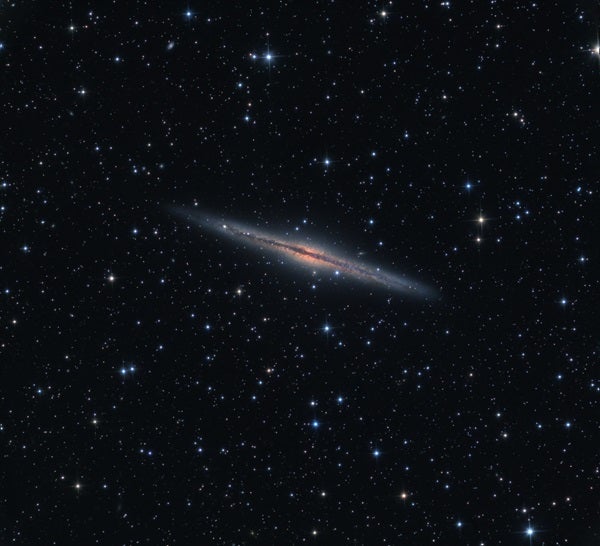Edge-on galaxies are relatively common among the thousands visible throughout the sky. Many even sport dust lanes splitting their galactic plane, adding visual intrigue. One such galaxy is NGC 891 in Andromeda.
Finding NGC 891 isn’t difficult. Start with Almach (Gamma [γ] Andromedae) and move your telescope 31/2° east. The Silver Sliver Galaxy, as NGC 891 is also called, is in a rich star field, which adds to its visual aesthetic.
At magnitude 10.8, this galaxy is visible with a telescope as small as 3 inches under excellent skies — but only just. Six-inch or larger optics are better, and in a 12-inch or larger scope with dark skies, the spiral’s disk starts gaining positive superlatives beyond, “Yep, there it is.” The thickness of this galaxy’s dark nebulae reduces its visual contrast with the background sky, making it harder to see than an edge-on galaxy without a dust belt. Using averted vision is a definite advantage here, so try wiggling the telescope or scanning the field while keeping the galaxy in the corner of your eye.
NGC 891 is classified as Sb, like the Andromeda Galaxy (M31). Since it’s edge-on, astronomers cannot determine its arm structure. Is it more like M31 or M81? We will never know. The Hubble Space Telescope shows that NGC 891’s dust and gas are distributed into numerous filaments, like fingers reaching out above and below the galaxy’s equator. Researchers hypothesize that these filaments were created by a combination of supernovae and the formation of energetic massive stars. NGC 891’s bilateral symmetry shows that it hasn’t collided with another large galaxy in the last billion years or so.
Other tidbits of trivia: Hollywood found the galaxy’s image so compelling that it appears in the credits sequence of The Outer Limits — among other objects described in Astronomy’s June 2019 story “The Outer Limits universe.” The soundtrack for John Carpenter’s 1974 film Dark Star included a track called “When Twilight Falls on NGC 891.” That same year, Edgar Froese released an album that included the song “NGC 891.”
Make sure to explore Astronomy’s full list of 101 cosmic objects you must see. New entries will be added each week throughout 2022.
To get the latest astronomical news and observing content delivered directly to your door, subscribe to Astronomy magazine today!










